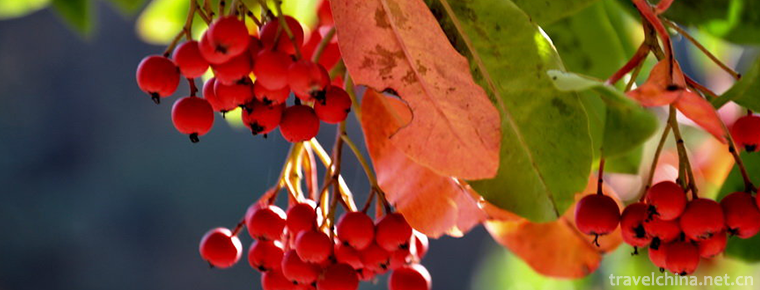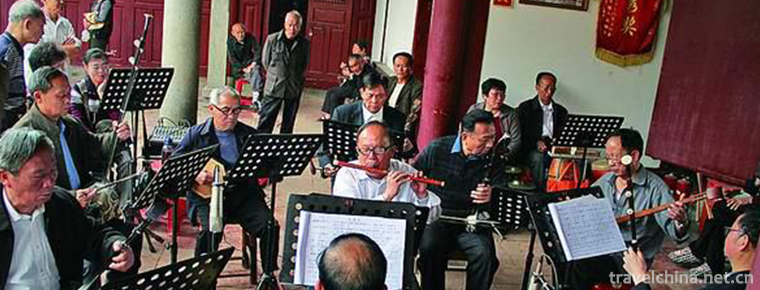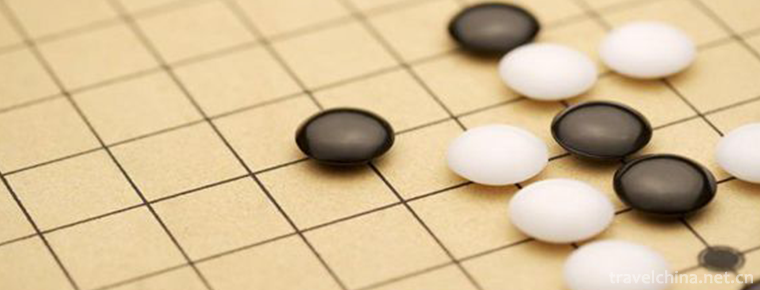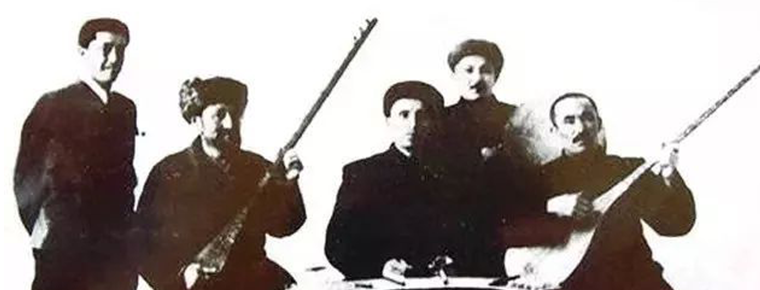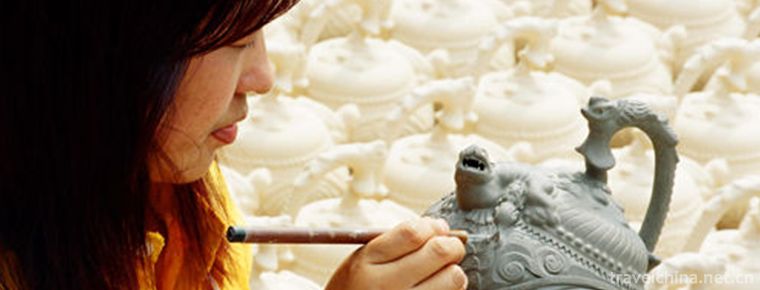Changde silk string
Changde silk string
Changde Silk String is a traditional local music popular in the Yuanjiang and Lishui areas of Changde, Hunan Province. At the end of Ming Dynasty and the beginning of Qing Dynasty, folk songs and tune tunes in Jiangsu and Zhejiang were introduced into Changde, which evolved and developed by combining with local folk music. Because it is the most developed and influential in Hunan silk strings, it already has the status of an independent type of music. Spreaded throughout Hunan, singing with silk strings, but also because of the use of Changde dialect singing, so called Changde silk strings.
Historical origin
Changde is one of the important birthplaces of Hunan-Chu culture. Since ancient times, the style of singing and dancing has been flourishing, and it is also a place where celebrities and elegant scholars gather together. It is known as "a country of cultural relics" and "a country of human origin". Local culture has also been influenced and nurtured by literary and artistic giants. Quyuan, Wang Anshi, Lu You, Yuan Hongdao and others have left a lot of works handed down here, which add splendid color to Changde culture and promote local singing and dancing customs to a higher level. According to Changde Fu Zhi, since Tao Yuanming's Taohua Yuan Ji of Jin Dynasty was handed down, literati such as Liu Yuxi of Tang Dynasty and Su Shi of Song Dynasty have gathered Taohua Yuan many times, and their poems and prose are very similar to those of Sixian of Changde. Since then, the "Peach Blossom Source" has been regarded by the artists of Changde Silk String as the embryonic form of the early singing lyrics of Changde Silk String.
During the Song and Yuan Dynasties, the economy of Changde city was further prosperous. Businessmen from all over the country gathered together. Along with them, musicians and song girls from Jiangsu and Zhejiang came and went between Yuanli. The seasonal songs they brought were also gradually spread in the lakeside areas. During the war in the late Yuan Dynasty, a large number of outsiders flooded into Changde, making the folk arts of various places widely exchanged. The recreational activities of Wangfu undoubtedly have a great influence on the development of folk songs and dances.
It is in this environment that Changde Silk String, a unique local music, has gradually formed. She inherited the Tang Dynasty poems and prose in the form of talking and singing. She drew lessons from the musical patterns of Zhugong Dialect, Yuan Zaju and Kunqu Opera, drew nutrition from local and provincial folk tunes and seasonal songs, and sang in common and understandable Changde dialect.
Since the mid-Qing Dynasty, due to the prosperity of commerce, Changde's culture and art have also been greatly developed. Changde's Sixian singing activities have gradually moved from the entertainment of literati and refined people to the market, and Changde people have the habit of drinking large bowls of tea, so Changde's Sixian found the gestation placenta in the tea club. In order to attract business, businessmen have invited silk string artists to sing to congratulate them. With the increasing popularity of the art of silk strings, during the Daoguang period, there were geishas who took singing songs as their profession. The Silk String Band Society has emerged in various places, and a number of successful silk string artists have emerged. They have worked with literati and ink writers to compile silk string albums. One of the most influential is He Xiaokun, whose traditional repertoires are Shuangxia Shan, Erdumei and Daiyu Funeral Flowers.
At the end of the Qing Dynasty, silk-stringed woodcut albums were published in Changde Xiaofuxiang, Changde, Lixian and other places, forming a street of workshops'printed albums. The engraved albums include "Mengjiang Female Searcher" and some minor tunes, which are called "tune books" or "hall class tunes". Since then, Changde Silk String Qupai has spread in the streets and alleys.
At the end of Qing Dynasty and the beginning of the Republic of China, the introduction of western music and Peking Opera had a certain impact on the development of Changde's string music. At this time, the activities of silk string singing radiated from the city to the countryside. In order to meet the needs of long-term performance, the silk string artists put their eyes on the opera. They transplanted the repertoire and borrowed the technique of creating the tune of the opera board, thus forming the "old road" of Changde silk string and singing a long story easily. Xu Meiqing, a famous silk string musician, and others transformed the tunes from Sichuan, imitated the old road and created a new "Chuanlu" tune, which made the slab tune of the silk string music more perfect and popular in Yuanli.
The loud gunfire of the Japanese invaders concealed the elegant new sound of the Changde silk string. The bloody battle in Changde made the army and people of Changde suffer tremendous sacrifices, and the Sixian of Changde also suffered unprecedented misfortune. Suddenly, the Silk String Band Society collapsed one after another, and the silk string artists were forced to make a living, so bored people could only beg and sell their art along the street.
After the founding of the People's Republic of China, Changde Silk String Art gained new life. Folk artists performing groups have been set up in various places, and relevant government departments have organized forces to help artists improve their old ideas, collect and sort out traditional songs, and literary and artistic workers and folk artists have jointly reformed the silk strings and created new tracks.
During the Cultural Revolution, all the silk string singing groups were impacted and disbanded successively. Since then, many intellectuals have collected, sorted out, studied, or made a vigorous appeal for the rescue of the endangered Changde Silk String. Huang Hui, known as "the first person of Changde's silk string", has been engaged in silk string work for more than 20 years. He has collected hundreds of thousands of words of silk string data and a large number of music scores. He has changed his manuscripts seven times and finally completed a volume of Changde's Silk String Music Collection, which is printed as a volume. In 2008, the book Changde Silk String was published, which was included in the series "Changde City Building a Cultural City".
artistic characteristics
Changde's stringed music structure is complete, singing method is unique, performance form is flexible and free, accompaniment technique is rich and colorful, so it has a unique charm and touching charm, so it lasts forever and is deeply loved by people.
Changde Silk String's music and language, melody and tone have their own system. Its theme and genre have the common characteristics of typical rap music. What is more noteworthy, worth studying and researching is that its music structure is complete, singing method is unique, performance form is flexible and free, accompaniment technique is rich and colorful, which is beyond many kinds of music. Comparable. These factors constitute the strong personality characteristics of Changde Silk String.
Musical Structure and Singing Method
Changde Silk String Music has a relatively complete system, and its musical function has its unique features. It combines narrative and Lyric features. It can not only express historical stories, but also rap and sing folk customs, and in the creation of tunes and singing, it mainly conveys feelings and ideas. It pays special attention to the method of "speaking with singing, singing with speaking, tune with word out, sound with rhyme" and emphasizes colloquialism and speaking. While singing, we should pay attention to the beauty, beauty and lyricism of the melody.
(1) There are more than 300 tunes in the traditional Changde string music, most of which are based on historical stories and traditional folklore. It is divided into three types: Qupai body, plate cavity body and mixture body.
Qupai style, also known as brand silk string, is a kind of divertimentary music that links many pieces with complete and independent contents and reflects a common theme. It is the most basic and common form of Changde silk string singing. Changde Silk String has more than 100 tunes in common use. These tunes with different contents, styles and techniques have fully demonstrated their own characteristics and elegance through long-term winding and tortuous singing practice. Some of these tunes can be linked with other tunes or singing separately, while others are only suitable for singing separately, but most of them have good overall function by linking with other tunes. Because of the use of a number of different melodies, different structures, different rhythms, and even different tonal tunes for singing, greatly enriched the expression of music, thus achieving a more perfect artistic effect.
Banqiang music, also known as wrench silk string, is a kind of Banqiang music which has the characteristics of opera music and is an important part of Changde silk string music. It has a complete system of singing voice and genuine appeal. It is an essential basic music for singing large-scale repertoire (silk string opera). It includes two kinds of voices, the "old road" and the "Sichuan road". According to the old silk string artist, "Old Road" is evolved from local folk music, while "Sichuan Road" is closely related to local operas in Sichuan. Most of the "old roads" are deep, vigorous and agitated, while the "Sichuan Road" is generally clear and broad, vigorous and powerful. "Old Road" and "Chuanlu" respectively include three basic platforms, , , , and usually have uniform structure, clear arrangement, melodious melody, orderly rules, narrative and singing, as well as emotional expression, strong expressive force and impetus; and is a tightly-knitted form of scattered board, its rhythm is free and flexible, the melody fluctuates and falls, and is good. In the performance of grief, resentment, agitation and fluctuation of thoughts and feelings.
In addition, there are mixtures. According to records, it is a new form of music structure appearing after the 1930s. It refers to the mixing of music in a repertoire, such as music in the form of music plate, music in the form of board cavity, or music plate with a kind of board, or "Lao", "Chuan" and other kinds of board and one or more music plates. This structure is mostly used in medium and long repertoires.
In Changde's stringed music, whether short, medium or long, whether it's a melody, a board cavity or a mixture, it pays attention to the structural principle of "rising, flat and falling". Its musical melody is characterized by a five-degree leap.
The sentence structure of Changde Sixian is mainly composed of two sentences, four sentences and long and short sentences. The two-sentence style is very common in Qupai melodies. The two-sentence style is composed of the following sentences as the basic structural principles. Four-sentence style usually constitutes musical paragraph according to the principle of starting, inheriting and transferring. It is a common structural form in Qupai melody. The long and short sentences vary with the structure of Qupai sentences.
Changde's silk chords vary in tone and color. Qupai music is mainly composed of levy mode, commercial mode, palace mode and feather mode, while angular mode is seldom seen. Most of the "Chuanlu" tunes in Banqiang music are six-tone G-quotient. "Old Road" singing is mostly C-mode.
(2) Changde Sixian sings in Changde dialect centered on Laogaoshan Street, Changde City. Not only can Southerners hear it clearly, but also northerners can understand it. Its singing not only conforms to the aesthetic habits of the broad masses of the people, but also has a unique style. Changde people say their dialect is like singing, especially for women. It is soft and graceful, like a breeze on their face. Therefore, some people say that "Changde Sixian's music is a linguistic music, but language is a musical language". The two well-known words "Eh, Eh" seem to have attached a label to the string of Changde, where it can be placed at a glance. (3) While emphasizing oral and rap, Changde Sixian pays more attention to the beauty, lyricism and musicality of the melody so as to make the lines soft, beautiful, tactful or cheerful, jumping and humorous. According to the artist, "Word-biting weighs a thousand kilograms, and the listener can look at it automatically." Artists pay attention to "tune from the word, sound with rhyme" to make the melody more lively and dignified.
Because of dialect and artists'hobbies and interests and the needs of plot development, different artists can sing the same music with different charm and produce the same effect; even if the same music with the same brand and the same music with the same artist, they may also use different methods of cadence and setback when they can line their tunes to get the change of melody by embellishing their tunes. Taoyuan artist Li Yucheng's singing voice is like running clouds and running water, sometimes clever and light, sometimes implicit and deep, sometimes vigorous and strong; Changde artist Dai Wangben sings by himself, the singing voice is vigorous and strong; Jinshi artist Huang Xueqian's singing voice is simple and honest. Artists'different singing characteristics gradually formed different styles and schools.
Changde Silk String's traditional singing method is very particular about self-playing and self-singing. It requires actors to have a sweet, crisp, mellow voice, together with the embellishment technique adapted to the characters'personality in the plot, and depicts various characters by changing the voice to tell and sing stories. According to the needs of rap and story telling, actors should be able to enter the role at any time, that is, "in and out", sometimes they are rappers, and sometimes they play the characters in the play. Because of the variety of performances of Changde Silk String, in the book Hunan Folk Music Census Report published by China Music Research Institute in 1955, Changde Silk String was classified as a kind of opera. It can be seen that at that time, some of Changde Silk String's repertoires adopted some performing techniques of opera. Changde Silk String has always had many highly skilled singers. Through their continuous inheritance and development, Changde Silk String has become a popular singer, easy to sing, easy to remember and easy to learn.
Performing Form and Accompaniment Method
Changde Silk String is a kind of traditional folk rap and singing performing art with singing as the main part, speaking as the supplement, both rap and singing as well as various changes. It can not only sing short and concise tunes, but also sing large repertoires with plots and stories. When singing silk-string passages, the singer is often "one person, many angles", "in and out", which is only a simple form of opera; while singing large-scale repertoires, it is a dramatic structure (that is, silk-string opera). Especially, unlike the former form, the singer has to enter the role from beginning to end, and how many people in the repertoire will play it. In addition, the silk string segment can be divided into two different forms: one is Lyric segment. This type usually pays no attention to the plot of the story, but concentrates only on praise and praise of one thing or thing. When singing, it usually matches the same tune with multiple lyrics, but changes the melody slightly according to the line of words. The other is the narrative monograph. This type mainly deepens the theme idea with more complete story plot and detailed description of characters, and according to the needs of different content, mood and style, it sings several different tunes with bead-to-bead composite suite, which is widely used in Changde's silk string singing.
(1) The traditional singing form of Changde Silk String is sitting. Most of them are long silk strings with stories and characters. The singers are usually 6. When performing, the artists pay much attention to the seating position, such as "dulcimer to drum board, Gaohu to erhu, three strings to pipa". Performers should be able to play and sing by themselves, one person with many roles, and use their voice to shape all kinds of characters, such as Sheng, Dan, Jing and Ugly, and to tell and sing stories. If there are more roles in the singing repertoire than the singer, then each person takes part in the singing repertoire apart from one of the main roles. Li Yucheng, an old silk string artist commonly known as "one person, one drama", is the most famous one. She is good at blowing, pulling, playing and singing, and sings with her own accompaniment. Changde Silk String is usually sung in the house, hall and teahouse.
With the continuous advancement of the times and people's increasing pursuit of cultural life and appreciation and identification level, Changde Sixian's singing art has been constantly reformed, developed and matured, and the singing form has gradually diversified, not only singing, singing in pairs, group singing, performing singing, etc., but also as a silk string opera onto the stage. Since the late Qing Dynasty, silk string artists have tried to "hang up their clothes on the stage" (wear costumes to perform). After liberation, the exploration of this opera style has intensified. Changde and Taoyuan have discharged a number of silk-string operas, some of which have participated in provincial and local theatre performances and won prizes, and some of them have participated in the performance of the Beijing Opera Research Society. At the same time, there are special bands, no longer actors and musicians, accompaniment instruments also increased.
(2) The main accompaniment of Changde silk strings is Huqin, which has a larger tube than Beijing Hu and a smaller tube than Erhu, while Lixian Prefecture uses Sihu as its main musical instrument. Sometimes for the needs of the program, there are also Beijing Hu or Gaohu.
The traditional plate drum used in Changde silk string is a special kind of small plate drum. It resembles an inverted rice bowl and is made of a big bamboo pocket. In the early 1940s, silk strings were added to gongs and drums percussion music of Han opera and Huagu opera, and used in live music to exaggerate the atmosphere.
In the accompaniment of silk string singing, there are five basic methods: supporting, wrapping, lining, cushioning and garnishing. The supporting tune, that is, the accompaniment melody is the same as the singing tune, only changes in some places, with a relatively fixed rhythm to set off, in order to highlight the singing tune. Enclosure, that is, accompaniment melody is basically the same as aria, but in some places it is required to add flowers on the basis of aria melody, so as to achieve the degree of blending of the two. Lining tone, the accompaniment is required to set off the charm of the singing tone, which is rich and colorful, but not noisy, and the accompaniment and the singing tone are inseparable. Cushion tune, in some of the tune pause or singing breath, with accompaniment music cushion, plays the role of connecting the preceding and the following, coherent singing. Flower accompaniment is a common technique. In the process of supporting the tune, the accompaniment is often modified and flourished by adjacent tones and passing tones, so as to enhance the expressive force of music.
In order to adapt to the change of people's aesthetic psychology, hobbies and appreciation habits, Changde Sixian's orchestral accompaniment has made a bold attempt to expand the orchestra compilation and the mix of Chinese and Western instruments. Since 1957, when Changde's traditional Silk String repertoire Shuangxia Shan was arranged and performed, most of the repertoires performed by professional quyi (literary and artistic) groups have simple accompaniment score. The number of musical instruments increased from 6 to more than 10, including Beijing Hu, Zhonghu and cello.
According to data, in 1975, Changde's string repertoire "A Round of Red Sunshine in the Chest" in the stage art film "New Flowers in Mass Literature and Art" used a small Chinese and Western orchestra, which was accompanied by a mixed orchestra composed of Yangqin, Beijing Hu, Erhu, Pipa, cello, flute, clarinet, bass, horn and trumpet. Since then, the accompaniment of Changde Silk String has added many colors and produced new artistic effects. It has taken a very important and fruitful new step for more complete, more direct and more vivid characterization and deepening the plot of the story.
Musical form
Changde Silk String is mainly composed of singing, supplemented by speaking, and interluded with rap and singing. It not only sings Lyric passages, but also sings large passages with characters and plots. Its singing dictionary is elegant, melody is beautiful, the repertoire is rich, the structure is complete, the tone is diverse, the melody is clear and catchy, is a popular music form in the mass compilation, singing activities.
Changde Silk String has more than 100 traditional repertoires, most of which are based on historical stories and folklore. Among them, the excellent traditional songs Baoyu Crying Ling, Lu Zhi's Deep Drunk Hitting the Mountain Gate, Shuangxia Shan, Wang Po's Cursing Chicken, Zhaojun's Out of Fortress have always been loved by the masses. After the founding of the People's Republic of China, a number of new songs reflecting real life emerged, such as "New Things More", "Quarantine Lang", "Wind and Snow Visiting Relatives", which were widely sung throughout the country. Since the 1980s, Changde Silk String has been reviving. For example, "Melon in Love", "Golden Plaque to Hang", "Beautiful Mother's College" and other tracks won the national "Star Award" gold medal, as well as "Zhilan Yayun" and other tracks to perform in Malaysia, deeply loved by overseas friends. Changde Silk String has produced a wide range of social impact at home and abroad, with high cultural and artistic value and social practical value.
Changde Silk String has its own local characteristics and local flavor. Its own style of music, singing and performing forms are of great protection value. However, due to the lack of professional performing groups, together with the death of the older generation of silk string artists, more than 100 tunes have been lost, and other factors, it has been in a state of withering and endangered.
The protection of excellent traditional Changde silk strings has attracted the attention of relevant departments. The Changde Municipal Committee, the Municipal Government and the Municipal Cultural Bureau have worked out practical rescue and protection measures through several special meetings, and are organizing and implementing them.
Inheritance significance
Changde Silk String has distinct local characteristics and local flavor, and its artistic value is high. However, due to the lack of professional performing groups since the 1980s, and the death of the older generation of silk string artists, they are facing the danger of losing their heritage and are in urgent need of rescue and protection.
representative figure
Yang Jian e
Female, born in May 1945, a member of the Communist Party of China, a second-class national actor, a member of the Chinese Dramatists Association, a member of the Hunan Provincial Society of Directors, and a retired cadre of the Dingcheng Theatre Studio, Changde City.
Yang Jianye was born in the family of Liyuan. She was seven years old and attended the theatre troupe to perform. She has worked tirelessly for more than 50 years. She has performed more than 100 performances while directing. She is the successor of Changde Huagu Opera, but she has made great contributions in promoting the cause of Silk String. More than 150 Changde Silk String Programs were directed, of which 16 were awarded the Grand Prize in Jinjing. Among them, Changde Silk String "Pillow Wind" won the Peony Award, the highest prize in Chinese opera. She devoted all her life energy to her beloved cause of Changde Silk String, which can be said to be "the end of spring silkworm to the end of silk, wax torch into ash and tears to dry".
Main representative works:
In 1997, Yang Jianye led the cast of Changde Sixian's "Golden Plaque to be Hang" to participate in the finals of the Stars Award in Nanjing. The performance was quite successful and won the 7th Stars Award.
When directing the silk string drama "Special Bride", he made great efforts to innovate in music design and stage setting, and enhanced the era color and performance effect of the program. He participated in the finals of the National Small Opera and Sketches "Stars Award" held by the Ministry of Culture and won the Gold Prize.
He directed the first self-created Changde Silk String TV drama "Rotating Banknotes" and won the "Flying Award" in one fell swoop.
In July 2005, Changde Sixian's Pillow Wind, directed by her, was awarded the top quality program of the Fifth Chinese Quyi Festival. In November, she represented Hunan Province in the 4th National "Four Entry Communities" Fine Arts Exhibition jointly organized by the Central Civilization Commission, the Ministry of Culture and CCTV, and won the Golden Prize. In September 2006, she was awarded the Fifth National Quyi-Peony Award.
In November 2006, Changde Sixian's Unfinished Birthday Banquet, directed by her, represented Hunan Province in the 5th National "Four Entry Communities" Fine Arts Exhibition jointly organized by the Central Civilization Commission, the Ministry of Culture and CCTV, and won the Gold Prize.
Xiao Ling Zhu
National intangible cultural heritage project successor, September 1985-June 1990, studied in Changde Flower Drum Performance Class of Hunan Art School, graduated in July 1990 and assigned to work in Changde Silk String Art Troupe. In December 1999, he served as the head of the business troupe of Changde Art Troupe until October 2004. He was admitted to Hunan Art School in 1985 and was subordinated to Mr. Yang Jianye. Over the past 20 years, under the teacher's teaching, we have mastered the singing style and performance form of Sixian Changde. Now we have inherited more than 40 traditional plays and new scripts. In August 1989, I was fortunate to have the personal advice of Mr. Dai Wangben, the elder inheritor of Sixian Changde. Graduated in 1990 and assigned to the Changde Silk String Art Troupe, mainly engaged in silk string performance, as well as the inheritance, popularization and promotion of Changde Silk String. There are 8 students, Xiong Lixia, Huang Zhimin and Deng Danye. Every year, there are no fewer than five industrial silk-string programs created jointly with enterprises and institutions. Over the years, she has been active on the stage of Changde Sixian and has created many vivid characters. He is currently the deputy head of the Changde Silk String Art Troupe and the leading actor.
Technical characteristics
The typhoon is rigorous, the voice is sweet, the performance is delicate, the singing words are correct and the characters are good at portraying.
Personal achievement
In 2004, he served as a second-level national actor, won four provincial and ministerial awards, five awards from the Ministry of Culture, and three of them won gold medals. As a result of outstanding performance, outstanding results. In 2001, he was awarded the honorable title of "Young and Middle-aged Literary Artist of Hunan Province in 2000" by Hunan Literary Federation.
Exhibitions, performances, collections, exchanges, publications and awards of major representative works and works
September 12, 1989: Changde Sixian's "Whisper in the Cave" participated in the first Chinese Wing-counting Fertility Performance and won the "Excellent Performance Award".
May 26, 1991: Changde Sixian's "Melon in Love" won the "Gold Prize" at the first Chinese Quyi Art Festival.
December 1997: Changde Sixian's "Golden Plaque to be Hang" won the "Golden Prize" awarded by the Ministry of Culture in the 7th National Star Awards.
October 1999: Changde Sixian's "Golden Plaque to be Hang" won the Hunan Provincial "Spiritual Civilization Award".
November 1999: The large-scale modern silk string opera "Rotating Banknote" participated in the Fifth Yingshan Red Folk Drama Festival of China and won the first prize for collective performance.
November 1999: "Rotating Banknote" participated in the Fifth Yingshan Red Folk Drama Festival of China and won the second prize for performance.
November 2000: The Rotating Banknote won the first prize for outstanding works of the "Five-One Project" in Changde City.
December 2000: "Rotating Banknote" participated in the third new play performance of Hunan Province and won the "Performance Award" awarded by the Provincial Cultural Department.
November 2003: Changde Sixian Guan Groom participated in the Eleventh China Population and Culture Award (Donghua Cup) and won the "Quyi Silver Award" jointly awarded by the Ministry of Culture and the State Administration of Radio, Film and Television.
March 2004: Hunan Federation of Literature and Art Circles was named as the young and middle-aged literary artist of "virtue and art" in Hunan Province in 2000.
June 2004: Changde Sixian's "Special Party Committee" won the "Silver Prize" awarded by the Provincial Department of Culture in the 4th Hunan Provincial "Sanxiang Star Award" small drama and opera competition.
In 2004, Changde Sixian's "Special Party Committee" won the silver prize of the 14th National Star Award.
In 2006, Sixian Changde's "Unfinished Birthday Banquet" won the Golden Prize from the Ministry of Culture and the Central Civilization Office in the fifth National "Four Entry Communities" Literature and Art Exhibition.
Chen Xiao Hui
In 1971, the successor of the national intangible cultural heritage project learned from the old silk string artist and worshipped him as a teacher. He mastered the basic singing method of Changde silk string and rehearsed many Changde silk string plays. He often participated in national, provincial and municipal tunes.
In 1973, 10 actors were recruited, and three of them, Longsai Curtain, Lin Hong and Huang Zuyi, were successively taught the basic singing skills of Changde Silk String.
It has been 36 years since I was engaged in folk singing and literary career. I have been engaged in group literary counseling for a long time and working in children's art troupe. Only by doing this, can Changde Silk String be inherited and developed. Silk String singing can maintain the status quo, use children to arrange children's silk strings, and create a series of children's silk strings programs.
With beautiful voice conditions, easy singing, clear pronunciation, accurate pronunciation, peer recognition, experts appreciate. Basic singing skills are solid, acting sketches, small plays, solo singing and dancing are all available, enriching their artistic path, and striving to achieve all-round development.
Personal achievement
He has been engaged in literary and artistic undertakings for 36 years from 71 to now. He has often participated in the provincial, municipal and national music competitions and won prizes. He has been engaged in professional performers for 9 years. He has a special love for Changde Silk Strings. In 79, the propaganda team was dissolved, and he was assigned to the Cultural Museum for group literary counseling. He is in charge of the minor art troupe. He has created and directed a large number of Changde Silk Strings and Children's Silk Strings performances throughout the country. Provincial and municipal awards were well received.
Choreographer
1. Children's Silk String "Silent Talk" participated in the first Hunan Youth Art Team performance and won the gold medal.
2. Children's Silk String "Street Walk" participated in the provincial art program performance, won the Gold Prize for Creation and Silver Prize for Performance.
3. Children's Silk String "Moon Baba" participated in the National Television Art Competition and won the Silver Prize.
4. Children's Silk String "Childhood" and "Water Battle" participated in the provincial performance and won the silver prize.
5. The silk-string singing and dancing "Horse and Horse Doodle Riding" won the silver prize of the National Grand Prix and the gold prize of the provincial art festival.

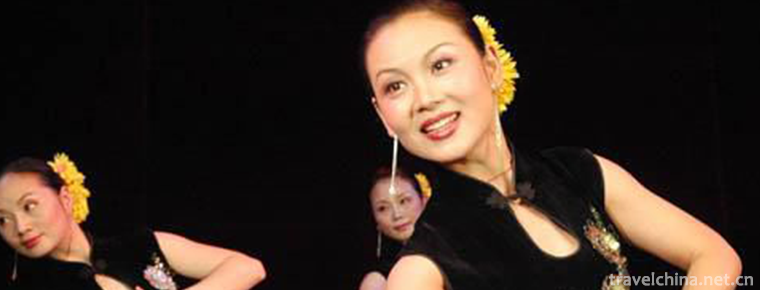
-
Yesanpo Scenic Area Laishui County Baoding
The Yesanpo Scenic Area of Laishui County, Baoding City, Hebei Province, is located in Laishui County, Baoding City. The Taihang Mountains and Yanshan Mountains.
Views: 188 Time 2018-11-24 -
The Huaming Tower Scenic Area
Huaming Tower Tourist Area: National AAAAA Tourist Area, National Key Cultural Relics Protection Unit, National Patriotic Education Base..
Views: 169 Time 2018-12-12 -
Wucai Beach
The Wucai Beach is located in Buerjin County, Altay area, north end of Xinjiang. It is located on the first and second terraces on the North Bank of Ertiz River, the only one injected into the Arctic .
Views: 100 Time 2018-12-22 -
Tangjiahe Scenic Area
Tangjiahe Scenic Area is located in Qingchuan County, Guangyuan City, Sichuan Province. Subtropical monsoon climate. National AAAA-level tourist attractions. Established in 1978, it covers a total are.
Views: 252 Time 2019-02-13 -
Puxian Ten Sounds and Eight Musics
Puxian Ten-tone Eight Music is not only the traditional folk art folk rap music in Putian area, but also the instrumental music. Ten tones, also known as ten times, are a comprehensive art of instrume.
Views: 152 Time 2019-06-09 -
The game of go
Go is a strategic two-player game. It was called "game" in ancient China and "Go" in the West. Popular in East Asian countries (China, Japan, Korea, Korea), is one of the four arts.
Views: 283 Time 2019-06-26 -
Uzbek Ehilai and Yelai
Uzbek Ehilai and Yelai are mainly distributed in Kashgar, Shache, Yecheng and Yining, Ili Kazakh Autonomous Prefecture, Xinjiang Uygur Autonomous Region. Uzbek people have excellent music and dance cu.
Views: 120 Time 2019-06-29 -
Firing Techniques of Yaozhou Kiln Ceramics
Yaozhou kiln is a treasure of Chinese traditional ceramic technology. It was created in the Tang Dynasty and matured in the Five Dynasties. It reached its peak in the Song Dynasty and declined gradual.
Views: 172 Time 2019-07-11 -
Topography and geomorphology of Suining
Suining is a hilly and low mountain area in the central part of Sichuan Basin, with simple geological structure and gentle fold. The landform type is single, belonging to the Mesozoic Jurassic strata, which is eroded, cut and accumulated by flowing water.
Views: 112 Time 2020-12-16 -
Neijiang cultural undertakings
By the end of 2019, there are 121 performing arts venues in Neijiang City, including 6 cultural venues. There are 5 museums, 5 cultural relics protection and management institutions, 7 national key cultural relics protection units, 42 provincial cultural relics.
Views: 281 Time 2020-12-16





